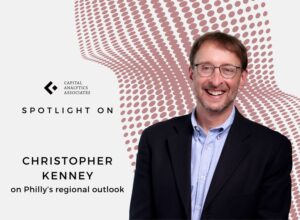 3 min read May 2023 — Christopher Kenney, principal of Strada, reflects on new advancements and methods at the design firm. Anticipating the client’s needs, as well as possible legislative changes, are important for the company’s success. “That moment when a client discovers you’ve given them what they didn’t know they wanted is just wonderful and gratifying,” he said in an interview with Invest:.
3 min read May 2023 — Christopher Kenney, principal of Strada, reflects on new advancements and methods at the design firm. Anticipating the client’s needs, as well as possible legislative changes, are important for the company’s success. “That moment when a client discovers you’ve given them what they didn’t know they wanted is just wonderful and gratifying,” he said in an interview with Invest:.
What are Strada’s recent accomplishments?
It’s been several busy years! The completion of B-Labs at Cira Center and a new headquarters for Biomeme are certainly highlights, as is our work on the historic tax credit-funded adaptive reuse of the The Battery at the Delaware Generating Station. Other successes include expanding our staff, opening a new office in the Research Triangle and growing our capabilities as a design firm.
What makes good design and differentiates Strada from other firms?
When the client walks into their completed space, and the project is both what they had hoped for all along and still a surprise, you know that you have created something that is responsive on the one hand, and transformative on the other. That moment when a client discovers you’ve given them what they didn’t know they wanted is just wonderful and gratifying.
What role does collaboration play in your work?
Many of the projects that we undertake are at a scale where design teams are really large. The projects become quite complex, whether they’re life science, multi-family, or institutional. There is usually a lot of knowledge at the table and our goal is to work well with other team members and to be a knowledgeable and creative voice. We want to have clients and professionals at the table who respect each other’s voices and expertise.
How is the current economic situation impacting Strada?
The most significant impacts are time pressures, inflation, and availability of capital. Not exactly an uneventful economic environment! Procurement of construction materials and equipment, particularly for life science projects, is significantly extended. It can take over a year to get generator sets for a laboratory project or even basic electrical equipment. This challenge is a legacy of COVID. It follows that we are asked to do our job of designing much more quickly so that projects can get into procurement queues. What was already an accelerated process based on the digitization of the industry has been even further accelerated by the pressure to procure.
As a result of inflation and demand, it costs us more to do that work faster. Inflation cuts across the entire commercial real estate and construction industry. Acquiring and keeping talent is a huge challenge. The salaries that people demand in an inflationary environment are very large.
Finally, running in tension with procurement pressures and inflation, we are seeing capital being less available to complete projects. It’s harder for developer clients to obtain capital, and entities that bring the capital are becoming more involved at the table during the design and construction processes. We’re seeing a significant slow-up regionally in commercial real estate that supports life science work.
What sustainable initiatives are in progress?
Within the company, we have a variety of initiatives to raise the level of our expertise. Some of those are formal programs like LEED, or other systems-based metrics for quantifying the sustainability of projects. On the digital side, sustainability features are becoming incorporated in architectural software. We now have embedded energy performance tools that provide a data set to inform specific design decisions.
Outside of the office sustainability initiatives are informing commercial real estate decisions. 10 years ago the idea of doing all-electric building systems in new construction was something an institutional owner or developer would never consider. There was cheap natural gas everywhere and so it wasn’t part of the equation. Developers are seeing regulatory actions on the horizon. We’re increasingly being asked to decarbonize buildings and to make them all-electric.
That said, the fact of the matter is that the electricity that’s coming to buildings is still being generated someplace using a high percentage of fossil fuels. There’s an awareness of the need to reduce carbon emissions and awareness that even if you’re not doing that because you want a clean conscience, heavy regulation is coming. Many of our clients are trying to get ahead of that.
What new trends do you see taking place?
Using gaming software to generate renderings is a signpost of how our profession will change and how digitization will continue to impact us. Possibilities in AI represent a tsunami of change. Certainly, parts of what architects do can be supported by AI.
What is your outlook for the region’s future?
Even though we’re at an odd, post-pandemic inflection point, I’m generally very optimistic about the Philadelphia region. Philadelphia is known as the “Celicon” Valley for its cell and gene therapy research and that will continue to grow. I’m hopeful that it will raise up the city by bringing new people here, and new skills and capacities to the people who live here. I am quite optimistic about the region and about Philadelphia.
For more information, visit:
